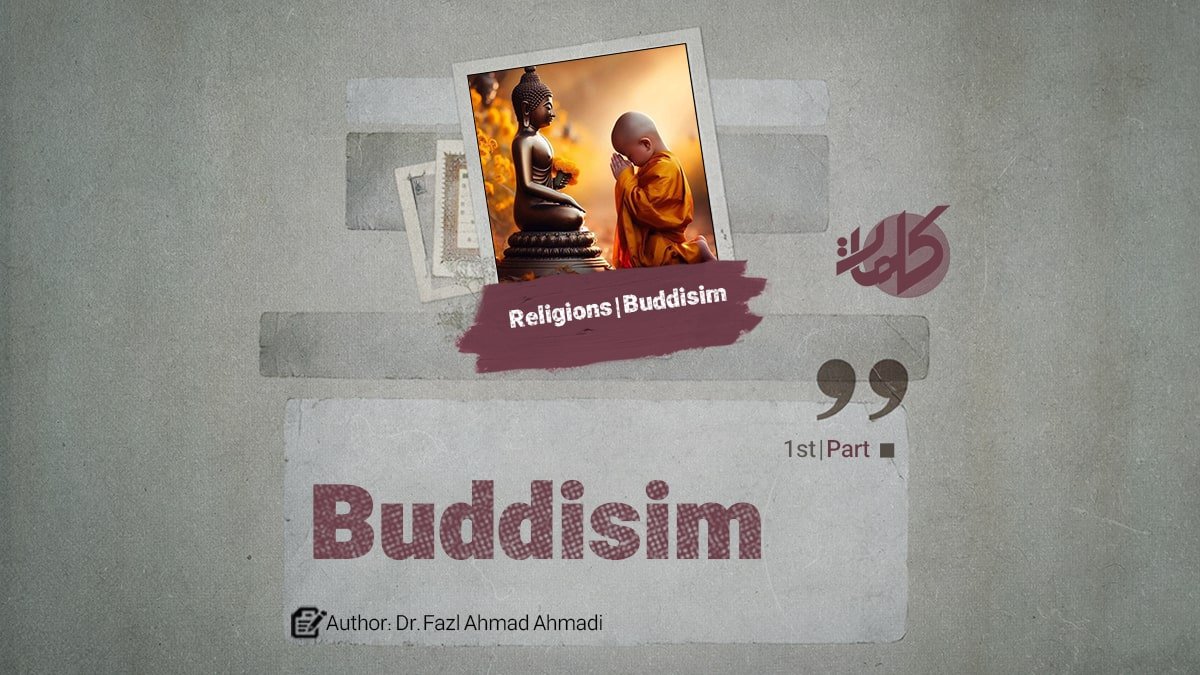
Author: Dr. Fazl Ahmad Ahmadi
An Overview of Buddhism (1st part)
Abstract
Examining and understanding religions, whether they are heavenly or human, is considered one of the major topics of universities and scientific centers of countries today; To the extent that many of these educational institutions have dedicated specific units for the analysis of this interdisciplinary debate.
Buddhism, as a religion, currently has its own habits and customs, and has taken a place among many people in Asia, especially in East and Southeast Asia; Therefore, it is necessary to have a source available for the Persian reader; According to this article, the basic question is how “Buddhism” is a religion and what changes have happened to this religion throughout history? In this research, to answer the above question, using the descriptive-historical method and with the help of available library sources, we found that Buddha was an ordinary person and a prince, and after seeing the misfortunes and unpleasant behavior of his tribe, he stayed away and practiced austerity in the corner of solitude from the behavior the common people and the nobles of the tribe, and after returning, he invited people to follow his sayings. Finally, after his death, his sayings were collected under different titles and slowly became a religion., which is followed by many today.
Keywords: Buddha, religion, followers, invitation and priority.
preface
The developments and influence of religions constitute the most important discussion in human history. Perhaps it can be claimed that there is no group and social class of human beings that does not have religious beliefs or at least human beliefs that ultimately rely on a place and a superior matter; Therefore, the study and recognition of religions is considered one of the most important topics in universities and scientific centers of countries today, to the extent that many of these educational institutions have dedicated specific units due to the importance of this interdisciplinary discussion.
The importance of this type of research is determined by the same title or the influence of religions on human society; As no word or belief throughout history has been influential in human societies like belief in religions, and most of the great developments and wars of the human world have been caused by a religious or anti-religious belief; Therefore, research and investigation in the field of religions is the need of all societies and every member of the society should be aware of their religions and beliefs.
In the field of religions, especially the great religions of the world, extensive research has been done, to the extent that there are dozens of books and articles in every language and culture that have analyzed the different discussions of religions, and a small number of these sources are also in the list of sources of this article. It has been mentioned; But the main point that has been paid more attention in this article is that the style and context of the explanation and the general and fundamental knowledge of “Buddhism” have been taken into consideration; A case that is not seen in other writings, or at least it was far from the author’s point of view.
According to the above, the basic question is how “Buddhism” is a religion and what changes have happened to this religion throughout history?
The current research that answered this question, with the help of library sources and using the descriptive-historical method, reached the findings that Buddha was an ordinary person and a prince, and after seeing the misfortunes and unwise behavior of his tribe, he changed the behavior of ordinary people. And the nobles of the tribe went far away and did austerity in the corner of solitude and after returning, he invited people to follow his sayings and finally after the death of Buddha, his sayings were collected under different titles and slowly became a religion, which today number Many follow it, it became.
1. Buddhism
According to tradition, Siddhartha Gautama, the seer of Buddhism, was born around 446 BC as the first son of Shudodane Shah from the Shakya tribe in Djekapile Vastu, located in the center of the tribe’s territory, in present-day Nepal. [Smith, 2007: 137] In other words, “Sudana” was one of the elite tribes of India; From this person’s wife, a child named “Siddhartha” was born, which is the same as “Buddha”. (Some scientists consider the birth date of “Buddha” a century before the mentioned date).
This prince had a high mind since he was a child; He studied holy and religious books very carefully; But he did not like the military operation, which was the subject of his tribe’s strong relationship! Therefore, he spends most of his time in thinking. The topics that occupied him the most were poverty, disease, old age and weakness, and ultimately death; “Buddha” was always thinking and looking for a solution to find a cure for them.
Although the early years of Buddha’s life were spent in luxury, he was not happy; He was worried about the problem of all humans and at the age of 29, he went from home to homelessness in search of an answer to this problem; After six years of asceticism, he became a Buddha (one whose eyes have been opened to the truth or the light) in Bodagaya under the Bo tree. From then on, he traveled throughout Central India until his death in Kushinara at the age of eighty. He preached the good news and became known by the honorable name of Shakiya Muni (the silent or holy sage of the Shakiya tribe). [Nakamura, Beta: 238, Al-Samouk, and Shammari, Beta: 41, and Walhamd, 1433: 71].
2. The relationship between Buddhism and Hinduism
Some Hindu scholars are of the opinion that Gautama Buddha was born a Hindu and died a Hindu, and the fundamental difference between his thoughts and the opinions and religious beliefs of Hindus and Hindu religious thinkers is that Buddha had a humanitarian (humanist) tendency and this trend distinguished his religion from what was considered Hinduism; But despite all this, it is sometimes said that the religion of “Buddha” is not only the inheritor of the important foundations of the Brahmin religion, but its spiritual color and religious nature is also influenced by Hindu spirituality, and some others consider Buddhism a branch of Hinduism. [Zarvani, Beta: 104 and Smith, 2007: 136].
According to the previous writings, the theories show that the main elements of Buddhism should not be incompatible and in conflict with the general principles of Hinduism, while this is not the case; Even Buddhism was considered a form of atheism by Hindus in the beginning; Because he not only did not believe in the two basic principles of “Hinduism”, i.e., the validity and heavenly authenticity of the Vedas and the belief in the existence of Vedic and Brahman gods; Rather, he denied them.
Unlike all schools of thought and Hindu religions, Buddha did not believe in any fixed truth and knew the world as a passing stream of unstable and momentary elements, and the only compatibility between Buddhism and Hinduism, as mentioned, is the law of cause and effect “Karma” or the principle of action and the results of action, as well as the acceptance of the principle of successive birth and death or “Samsara”. And if we consider these two principles as the criteria for aligning Buddhism with Hinduism, almost all Indian religions will have a single nature and the difference between them will only be related to their different names.
In fact, Buddhism represents a system completely different from Hindu principles; However, the subject of human suffering in the world, its cause and the necessity of salvation and liberation from suffering and the manner of this liberation in this religion, is different from what is intended and believed in “Hinduism”; Buddhism was therefore, at least in its earliest periods, a purely human religion; That is, no divinity can be found in it. [Zarvani, Beta: 105 and Walhamd, 1433: 74]
3. Buddha as legend
A number of scientists consider “Buddha” to be nothing more than a legend. The Dutch scientist Kern, using the legendary life description of the Buddha in the north of “Nepal, Tibet and China” published in Lulali Tavista, believes that the Buddha is nothing more than a legendary person and historically less valuable than Krishna.
Senart, a French Indologist, in his book called “Examination of the Myth of the Buddha” makes the Buddha the legendary hero of the sun: “Just as the sun emerges from darkness and ignorance, the Buddha is also born from Maya, i.e. imagination, his mother It is like the darkness that disappears after the sunrise (the Buddha dies sometime after his birth), just as the sun overcomes many clouds and turns its shining wheel in the sky, the Buddha also repels the devil and becomes victorious and the wheel applies the law; Buddha sets like the sun and descends towards the horizon, the flames of the cremation wood end his existence, just as the light of the last ray of the sun in the sunset makes the sun disappear from view.
“Salen Renac” writes jokingly: “In this case, we can imagine Napoleon as a legendary solar hero who is born on one island and dies on another island; He has twelve marshals, each of which is the sign of a month and completes the twelve months of the year.
“Aldenbark” considers Buddha as a historical figure; Because first: between Buddha and the first association of religious scholars who accepted the previous ideas and texts, there is not more than a century; Secondly: Buddha’s works in religion are mentioned in China; Third: They have found the place of Buddha’s birth, which is known from the stone that is there, and it was glorified by the great Buddhist king (Aska) in the third century BC. [Khodayar Mohebi, Beta: 49 and 50 and Saeed, Beta: 6].
continues…


